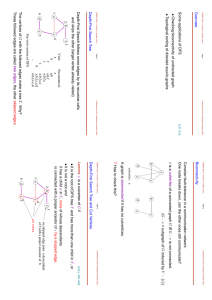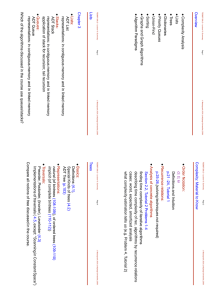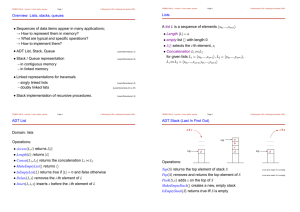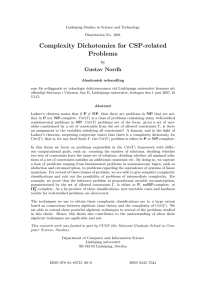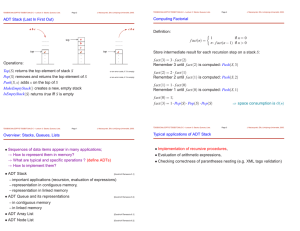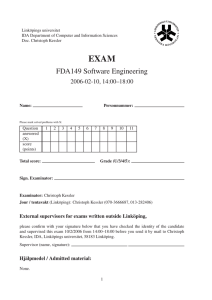TDDB56 DALGOPT-D – Lecture 3: Stacks, Queues, Lists . Page 2
advertisement
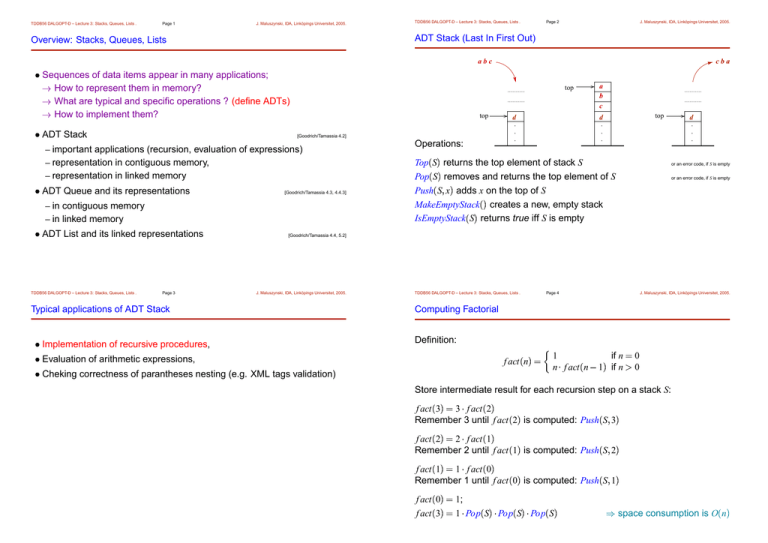
TDDB56 DALGOPT-D – Lecture 3: Stacks, Queues, Lists . Page 1 J. Maluszynski, IDA, Linköpings Universitet, 2005. TDDB56 DALGOPT-D – Lecture 3: Stacks, Queues, Lists . Page 2 J. Maluszynski, IDA, Linköpings Universitet, 2005. ADT Stack (Last In First Out) Overview: Stacks, Queues, Lists abc Sequences of data items appear in many applications; How to represent them in memory? What are typical and specific operations ? (define ADTs) How to implement them? ADT Stack top top [Goodrich/Tamassia 4.2] [Goodrich/Tamassia 4.3, 4.4.3] ADT List and its linked representations TDDB56 DALGOPT-D – Lecture 3: Stacks, Queues, Lists . top d . . . Top S returns the top element of stack S Pop S removes and returns the top element of S Push S x adds x on the top of S MakeEmptyStack creates a new, empty stack IsEmptyStack S returns true iff S is empty d . . . or an error code, if S is empty or an error code, if S is empty – in contiguous memory – in linked memory Operations: d . . . a b c – important applications (recursion, evaluation of expressions) – representation in contiguous memory, – representation in linked memory ADT Queue and its representations cba Page 3 [Goodrich/Tamassia 4.4, 5.2] J. Maluszynski, IDA, Linköpings Universitet, 2005. Typical applications of ADT Stack Page 4 J. Maluszynski, IDA, Linköpings Universitet, 2005. Computing Factorial Definition: Implementation of recursive procedures, TDDB56 DALGOPT-D – Lecture 3: Stacks, Queues, Lists . Evaluation of arithmetic expressions, f act n Cheking correctness of parantheses nesting (e.g. XML tags validation) 1 n f act n if n 1 if n 0 0 Store intermediate result for each recursion step on a stack S: f act 3 3 f act 2 Remember 3 until f act 2 is computed: Push S 3 f act 2 2 f act 1 Remember 2 until f act 1 is computed: Push S 2 space consumption is O n 1; 1 Pop S Pop S Pop S f act 0 f act 3 f act 1 1 f act 0 Remember 1 until f act 0 is computed: Push S 1 TDDB56 DALGOPT-D – Lecture 3: Stacks, Queues, Lists . TDDB56 DALGOPT-D – Lecture 3: Stacks, Queues, Lists . Page 5 A recursive call is tail-recursive iff the first instruction after returning from it is return. J. Maluszynski, IDA, Linköpings Universitet, 2005. tail-recursive functions can be rewritten using iteration The recursive call in fact is not tail-recursive: function fact (integer n) : integer if n 0 then return 1 else f n f act n 1 ; return f Page 7 Run-time stack immediately before calling fact(0) stack not needed: everything on stack will be discarded The first instruction after returning from the recursive call is multiplication n must be kept on stack TDDB56 DALGOPT-D – Lecture 3: Stacks, Queues, Lists . 1 return address 1 fact(1) 2 return address 2 fact(2) 3 return address fact(3) 3 on exit from the call: pop and discard the arguments go to the return address (free) ... function fact (integer n) : integer if n 0 then return 1 n f act n 1 ; return f else f for each function call: push arguments, local variables, return address (which form the function’s activation record), enter the procedure TDDB56 DALGOPT-D – Lecture 3: Stacks, Queues, Lists . Page 8 Tail-recursive function Tail Recursion Elimination Consider binarySearch: Both recursive calls can be eliminated: J. Maluszynski, IDA, Linköpings Universitet, 2005. function binarySearch (table key T a b , key K) : integer (1) if a b then return 1 middle a b 2 if K T middle then return middle else if K T middle then was: return binarySearch T a middle 1 K b middle 1 else K T middle was: return binarySearch T a middle 1 K a middle 1 goto (1) function binarySearch (table key T a b , key K) : integer if a b then return 1 middle a b 2 if K T middle then return middle else if K T middle then return binarySearch T a middle 1 K else K T middle return binarySearch T middle 1 b K Both recursive calls are tail-recursive. J. Maluszynski, IDA, Linköpings Universitet, 2005. Tail Recursion Stack application: Implementing recursive procedures The programming language implementation (compiler + run-time system) uses internally a stack to keep track of recursion. Page 6 J. Maluszynski, IDA, Linköpings Universitet, 2005. TDDB56 DALGOPT-D – Lecture 3: Stacks, Queues, Lists . Page 9 J. Maluszynski, IDA, Linköpings Universitet, 2005. Tail-recursive Factorial Function TDDB56 DALGOPT-D – Lecture 3: Stacks, Queues, Lists . n-1 J. Maluszynski, IDA, Linköpings Universitet, 2005. TDDB56 DALGOPT-D – Lecture 3: Stacks, Queues, Lists . Implementing a Stack in Contiguous Memory (2) J. Maluszynski, IDA, Linköpings Universitet, 2005. Implementing a Stack in Linked Memory function MakeEmptyStack() : pointer S NewCell(StackListHead) Λ ptop S return S x2 Info Next x0 Info Next ptop function Pop( pointer S ) : dataitem if ptop S Λ then error else y ptop S x In f o y ptop S Next y FreeCell y return x ... procedure Push( pointer S, dataitem x ) y NewCell(StackListItem) In f o y x ptop S Next y ptop S y S x1 Info Next function IsEmptyStack( pointer S ) : boolean return Length S 0 Page 12 function Top( pointer S ) : dataitem if Length S 0 then error else return A S Length S 1 Page 11 Length(S) = k + 1 <= n function Pop( pointer S ) : dataitem 0 then error if Length S else Length S Length S 1 return A S Length S A Length n S . . . . . . xk 0 f act2 is tail-recursive. space consumption after recursion elimination will be O 1 1) procedure Push( pointer S, dataitem x ) if Length S n then error else A S Length S x Length S 1 Length S x0 x0 function fact2 (integer n, integer f ) : integer if n 0 then return f else return f act2 n 1 n f 0 n S . . . function MakeEmptyStack() : pointer S NewCell(StackTableHead) NewCell(table dataitem AS Length S 0 return S xk function fact (integer n) : integer return f act2 n 1 All operations take O 1 time. J. Maluszynski, IDA, Linköpings Universitet, 2005. Implementing a Stack in Contiguous Memory (1) f act can be rewritten by introducing a help function: TDDB56 DALGOPT-D – Lecture 3: Stacks, Queues, Lists . Page 10 + maximum size need not be known in advance – call to NewCell in each Push operation and to FreeCell in each Pop operation TDDB56 DALGOPT-D – Lecture 3: Stacks, Queues, Lists . Page 13 J. Maluszynski, IDA, Linköpings Universitet, 2005. ADT Queue (First In First Out) TDDB56 DALGOPT-D – Lecture 3: Stacks, Queues, Lists . Page 14 J. Maluszynski, IDA, Linköpings Universitet, 2005. Implementing a Queue by a Ring Buffer last . . . x2 x3 x0 x1 0 a b c ... . . . abc first n-1 Operations: Front Q returns the first element of Q Dequeue Q removes and returns the first element of Q Enqueue Q x adds x at the end of Q MakeEmptyQueue creates a new, empty queue IsEmptyQueue Q returns true iff Q is empty S A Back Front Length = k < n+1 Length Typical application of ADT Queue: Serving requests in incoming order. Did you try to book a SAS ticket by phone? TDDB56 DALGOPT-D – Lecture 3: Stacks, Queues, Lists . Page 15 J. Maluszynski, IDA, Linköpings Universitet, 2005. TDDB56 DALGOPT-D – Lecture 3: Stacks, Queues, Lists . J. Maluszynski, IDA, Linköpings Universitet, 2005. Lists x2 A list L is a sequence of elements x0 xn 1 Info Next size or length L pFront pBack empty list with length 0 Selection by index i (sometimes called rank): selects the i-th element, xi where i is an integer in the range 0 n 1 ; Java code for the Queue operations: see course book, [Goodrich/Tamassia, Section 4.4.3] Selection by actual position, e.g. first element of L or last, next, prev,... Position abstracts from indexing. – overhead for NewCell in Enqueue, for FreeCell in Dequeue needs Θ k time) + maximum size need not be known in advance + pointer pBack allows Enqueue to run in O 1 time (without pBack: need to traverse the entire list n Q Page 16 x1 Info Next B mod n x0 F Pseudocode for the Queue operations: [Goodrich/Tamassia, 4.3.2] Implementing a Queue in Linked Memory Info Next n Back = index of last available cell; Front = index of the first element Length or Size to control overflow: ADT Vector: using rank ADT List: using position [Goodrich, Tamassia 5.1] [Goodrich, Tamassia 5.2] TDDB56 DALGOPT-D – Lecture 3: Stacks, Queues, Lists . Page 17 J. Maluszynski, IDA, Linköpings Universitet, 2005. TDDB56 DALGOPT-D – Lecture 3: Stacks, Queues, Lists . ADT Vector ADT List (1) Domain: lists Domain: lists Operations on a vector S Operations on a list L size 1 insertAtRank i x inserts x as a new element at rank i: increases the size; error if i 0 or i size 0 and false otherwise first returns the position of the first element of L; error if L is empty last returns the position of the last element of L; error if L is empty prev p returns the position of the element of L preceding p ; error if p is the first position. next p returns the position of the element of L following p ; error if p is the last position. removeAtRank i removes and returns the i-th element of S: decreases the size; error if i 0 or i size 1 returns true if S 0 or i isEmpty J. Maluszynski, IDA, Linköpings Universitet, 2005. elemAtRank i returns S i ; error if i 0 and false otherwise returns true if S isEmpty size L returns L returns S size Page 18 ...cont. next slide TDDB56 DALGOPT-D – Lecture 3: Stacks, Queues, Lists . Page 19 J. Maluszynski, IDA, Linköpings Universitet, 2005. TDDB56 DALGOPT-D – Lecture 3: Stacks, Queues, Lists . Page 20 J. Maluszynski, IDA, Linköpings Universitet, 2005. Implementing ADT Vector, ADT List ADT List (2) Update operations insertFirst x insert a new element x as the first element of L, return the position of x. insertBefore p x insert a new element x before position p of L, return the position of x. insertAfter p x insert a new element x before position p of L, return the position of x. remove p remove from L and return the element at position p of L, return the position of x. – elem retrieval operations in O 1 ; – what about other operations? insertLast x insert a new element x as the last element of L, return the position of x. Contiguous memory representation: elements stored in a table/ array (e.g. Dynamic Vectors Lecture 2). Singly linked lists: see next slide. – positions implemented as pointers – Analyze time complexity of the operations. – prev, insert Before require list traversal. Doubly linked lists: see below. TDDB56 DALGOPT-D – Lecture 3: Stacks, Queues, Lists . Page 21 J. Maluszynski, IDA, Linköpings Universitet, 2005. Singly Linked Lists TDDB56 DALGOPT-D – Lecture 3: Stacks, Queues, Lists . Info Info x0 x1 P Insertion D Prev Next (pFront) (pBack) L P Deletion L P TDDB56 DALGOPT-D – Lecture 3: Stacks, Queues, Lists . Page 23 J. Maluszynski, IDA, Linköpings Universitet, 2005. Insertion in a Doubly Linked List ...... Info Info x0 x2 Prev Next Prev Info x3 Next ...... Prev Next P Insertion: ...... J. Maluszynski, IDA, Linköpings Universitet, 2005. Doubly Linked Lists Prev Next L Page 22 Info Info x0 x2 Prev Prev Next Info x1 P Prev Next Info x3 Next Prev Next ...... Prev Info x2 Next Prev Next
